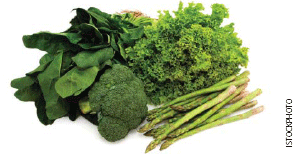In yet another example of the importance of eating healthfully, researchers from Lawrence Livermore National Laboratory (LLNL) have discovered that greens have a chemopreventive potential against the effects of aflatoxin poisoning. Aflatoxin is a naturally occurring carcinogenic mycotoxin associated with the growth of two types of mold, and it can be found in food and food crops including corn and corn products, cottonseed, peanuts and peanut products, tree nuts, and milk.
Moreover, because aflatoxins, particularly aflatoxin B1 (AFB1), are potent carcinogens in some animals, there is interest in the effects of long-term exposure to low levels of these mycotoxins on humans, according to the study, which was published in Cancer Prevention Research (2009;2[12]:1015-1022).
Researchers led by Graham Bench, PhD, and Ken Turteltaub, PhD, gave volunteers a small dose of carbon-14 labeled aflatoxin, an amount less than the amount that would be found in a peanut butter sandwich. In subsequent experiments, participants were given a small amount of chlorophyll or chlorophyllin concomitantly with the same dose of carbon-14-labeled aflatoxin.
The team then measured the amount of aflatoxin in each volunteer after each dosing regimen and determined whether the chlorophyll or chlorophyllin reduced the amount of aflatoxin absorbed into the volunteers.
The results revealed that co-consumption of chlorophyll and chlorophyllin, which are found in green leafy vegetables, may limit the bioavailability of ingested aflatoxin in humans. “The chlorophyll and chlorophyllin treatment each significantly reduced aflatoxin absorption and bioavailability,” Dr Bench stated.
“What makes this study unique among prevention trials is that we were able to administer a microdose of radio-labeled aflatoxin to assess the actions of the carcinogen directly in people. There was no extrapolation from animal models, which often are wrong,” Dr Turteltaub pointed out. ONA
